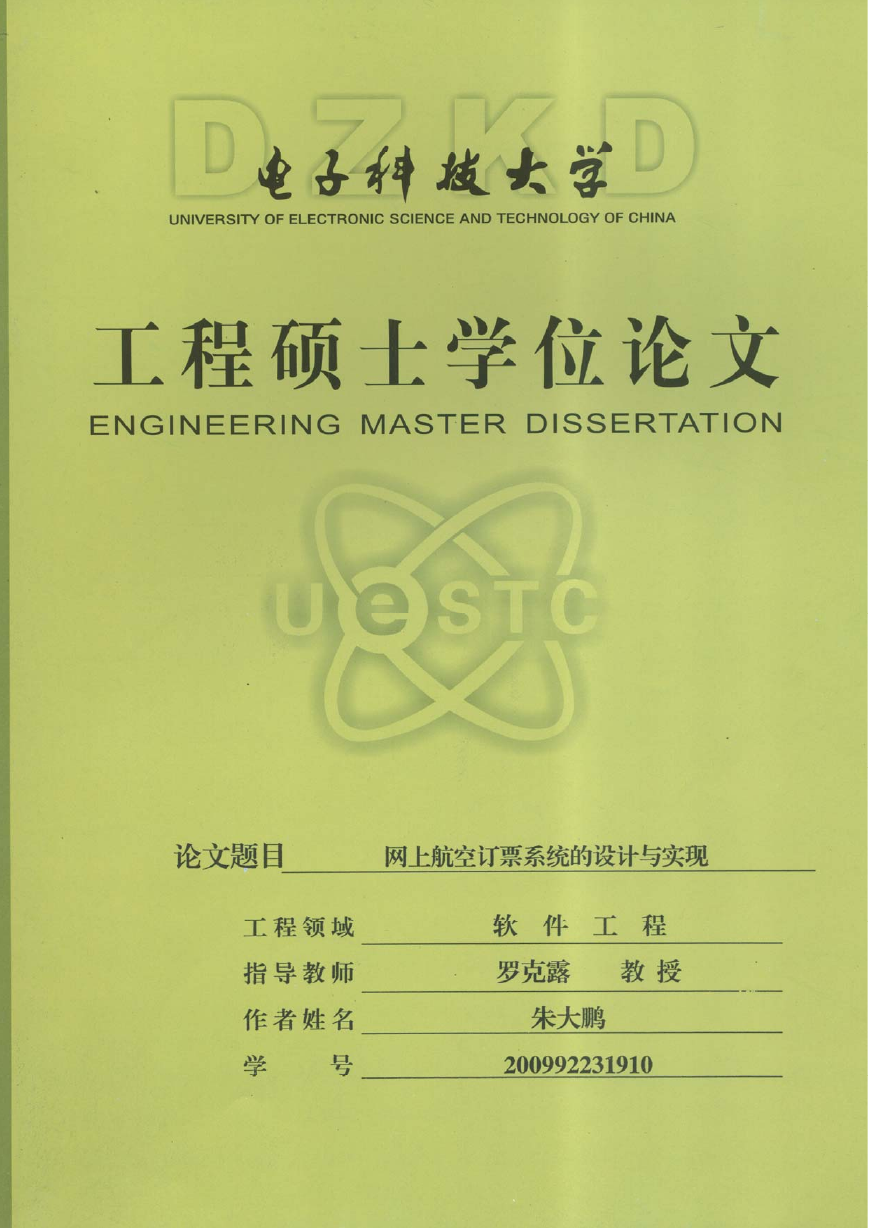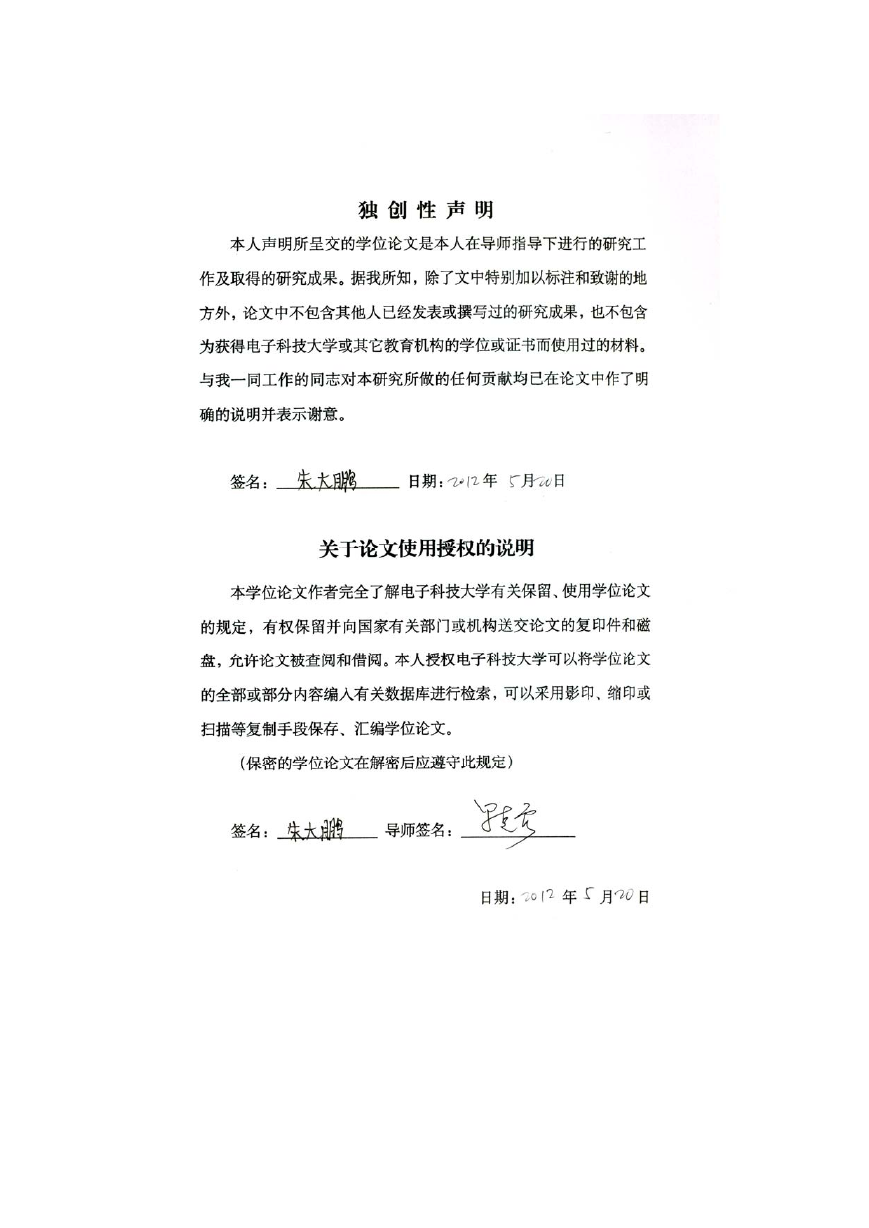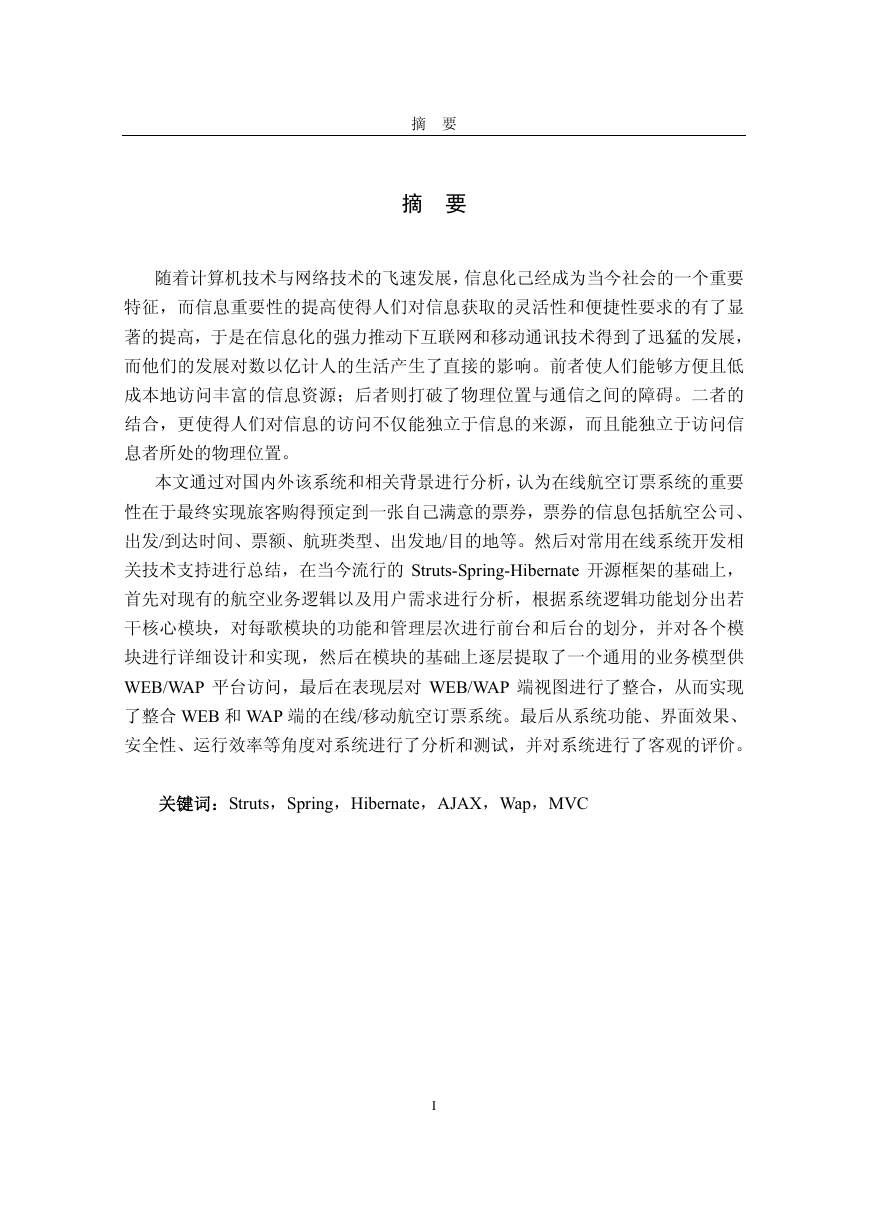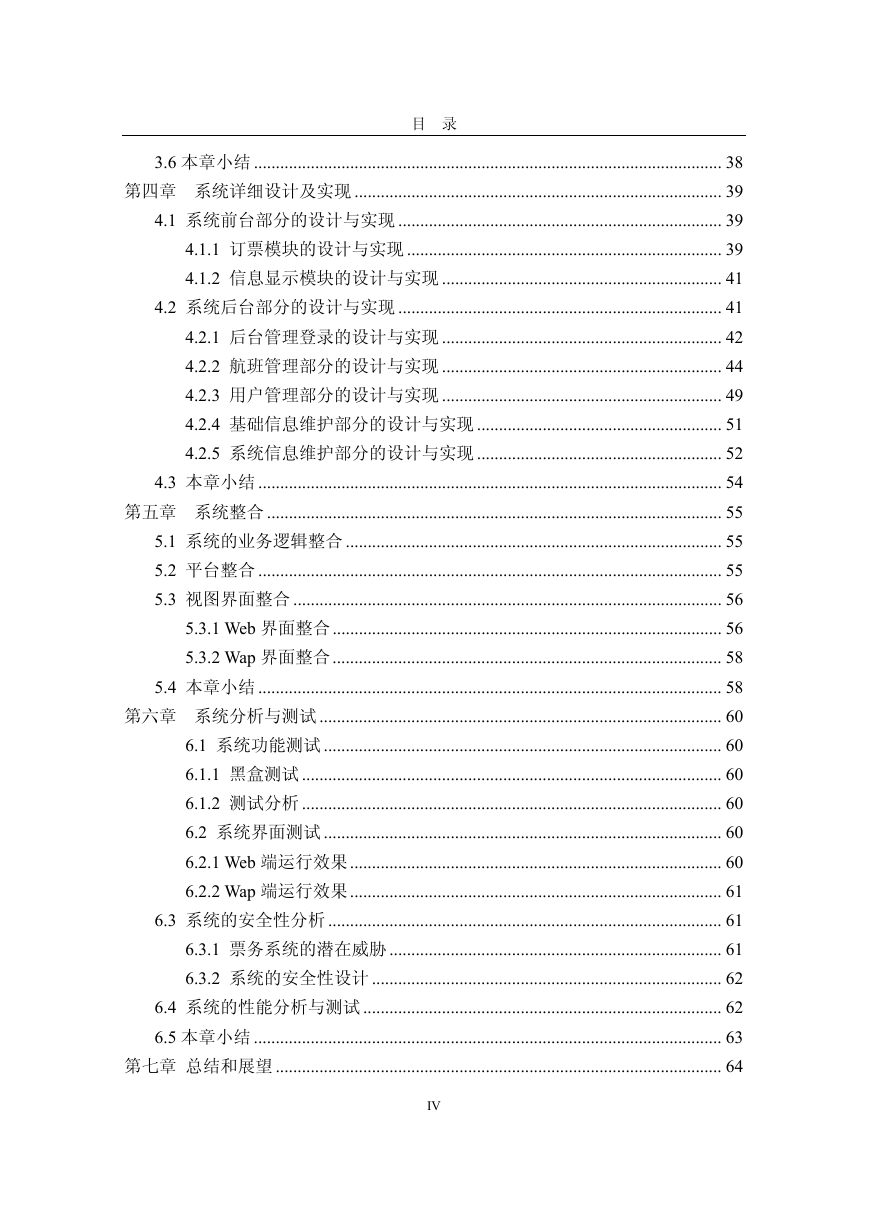�
�
摘 要
摘 要
随着计算机技术与网络技术的飞速发展,信息化己经成为当今社会的一个重要
特征,而信息重要性的提高使得人们对信息获取的灵活性和便捷性要求的有了显
著的提高,于是在信息化的强力推动下互联网和移动通讯技术得到了迅猛的发展,
而他们的发展对数以亿计人的生活产生了直接的影响。前者使人们能够方便且低
成本地访问丰富的信息资源;后者则打破了物理位置与通信之间的障碍。二者的
结合,更使得人们对信息的访问不仅能独立于信息的来源,而且能独立于访问信
息者所处的物理位置。
本文通过对国内外该系统和相关背景进行分析,认为在线航空订票系统的重要
性在于最终实现旅客购得预定到一张自己满意的票券,票券的信息包括航空公司、
出发/到达时间、票额、航班类型、出发地/目的地等。然后对常用在线系统开发相
关技术支持进行总结,在当今流行的 Struts-Spring-Hibernate 开源框架的基础上,
首先对现有的航空业务逻辑以及用户需求进行分析,根据系统逻辑功能划分出若
干核心模块,对每歌模块的功能和管理层次进行前台和后台的划分,并对各个模
块进行详细设计和实现,然后在模块的基础上逐层提取了一个通用的业务模型供
WEB/WAP 平台访问,最后在表现层对 WEB/WAP 端视图进行了整合,从而实现
了整合 WEB 和 WAP 端的在线/移动航空订票系统。最后从系统功能、界面效果、
安全性、运行效率等角度对系统进行了分析和测试,并对系统进行了客观的评价。
关键词:Struts,Spring,Hibernate,AJAX,Wap,MVC
I
�
Abstract
Abstract
With the development of computer and network technologies, informatization has
become an important feature of modern society, and the importance of information asks
for high demand for flexibility and convenience of information acquirement. Thus,
Internet and mobile communication techniques also obtained rapid development with
the strong push of informatization, which consequently influence lives of thousands of
hundreds of people. Internet makes people access plenty of information resource in a
more convenient way, and mobile technique break the obstacle of physical location and
communication. The combination of Internet and mobile techniques allow people to
access information resource independent of not only information source but also
physical location of information accessors.
This paper analyses through the system at background of home and abroad,and the
goal of our system is to make travelers subscribe needed tickets, which includes airline,
start/arrive time, price, airline type, start/arrive place and so on. In this article, then
commonly used in online system development support summary , we designed a system
achieved by the Struts-Spring-Hibernate framework, which is open-source and popular
today. First, we analyze the existing aviation business logic, and divided into a number
of core modules. Then on the basis of the module layer we withdraw a common
business model for the platform web/wap visit. Finally we integrate the view web/wap
end in the performance level. Thus we realize the integration of web and wap side of the
online / mobile air booking system. Finally, the system is analyzed and tested from the
interface, security, operational efficiency point, the system is objectively assessed.
Keywords:Struts,Spring,Hibernate,AJAX,WAP,MVC
II
�
目 录
目 录
第一章 绪论 .................................................................................................................. 1
1.1 研究背景 ............................................................................................................ 1
1.2 国内外技术发展 ................................................................................................ 1
1.3 本文的主要工作 ................................................................................................ 3
第二章 相关技术背景 .................................................................................................. 4
2.1 SSH 框架............................................................................................................. 4
2.1.1 为什么用 SSH.......................................................................................... 5
2.1.2 表现层框架 Struts................................................................................... 5
2.1.3 轻量级框架和 IoC 容器 Spring ............................................................. 7
2.1.4 持久层框架 Hibernate ............................................................................ 8
2.1.5 SSH 整合架构........................................................................................... 9
2.2 WAP 相关技术.................................................................................................. 15
2.3 AJAX 技术 ........................................................................................................ 17
2.4 本章小结 .......................................................................................................... 19
第三章 系统需求及总体设计 .................................................................................... 21
3.1 系统的设计目标 .............................................................................................. 21
3.2 系统的功能分析和模块划分 .......................................................................... 21
3.2.1 系统的需求分析 .................................................................................... 22
3.2.2 系统逻辑功能模块划分 ........................................................................ 24
3.3 系统的总体架构 .............................................................................................. 25
3.3.1 N 层架构体系结构 ................................................................................. 25
3.3.2 基于 SSH 架构的系统的架构设计....................................................... 26
3.4 系统的开发工具和运行环境 .......................................................................... 27
3.4.1 硬件环境 ................................................................................................ 27
3.4.2 软件环境 ................................................................................................ 28
3.4.3 系统开发环境 ........................................................................................ 28
3.4.4 系统测试环境 ........................................................................................ 29
3.5 后台数据库的设计与实现 ............................................................................... 29
III
�
目 录
3.6 本章小结 ........................................................................................................... 38
第四章 系统详细设计及实现 .................................................................................... 39
4.1 系统前台部分的设计与实现 .......................................................................... 39
4.1.1 订票模块的设计与实现 ........................................................................ 39
4.1.2 信息显示模块的设计与实现 ................................................................ 41
4.2 系统后台部分的设计与实现 .......................................................................... 41
4.2.1 后台管理登录的设计与实现 ................................................................ 42
4.2.2 航班管理部分的设计与实现 ................................................................ 44
4.2.3 用户管理部分的设计与实现 ................................................................ 49
4.2.4 基础信息维护部分的设计与实现 ........................................................ 51
4.2.5 系统信息维护部分的设计与实现 ........................................................ 52
4.3 本章小结 .......................................................................................................... 54
第五章 系统整合 ........................................................................................................ 55
5.1 系统的业务逻辑整合 ...................................................................................... 55
5.2 平台整合 .......................................................................................................... 55
5.3 视图界面整合 .................................................................................................. 56
5.3.1 Web 界面整合......................................................................................... 56
5.3.2 Wap 界面整合......................................................................................... 58
5.4 本章小结 .......................................................................................................... 58
第六章 系统分析与测试 ............................................................................................ 60
6.1 系统功能测试 ........................................................................................... 60
6.1.1 黑盒测试 ................................................................................................ 60
6.1.2 测试分析 ................................................................................................ 60
6.2 系统界面测试 ........................................................................................... 60
6.2.1 Web 端运行效果..................................................................................... 60
6.2.2 Wap 端运行效果..................................................................................... 61
6.3 系统的安全性分析 .......................................................................................... 61
6.3.1 票务系统的潜在威胁 ............................................................................ 61
6.3.2 系统的安全性设计 ................................................................................ 62
6.4 系统的性能分析与测试 .................................................................................. 62
6.5 本章小结 ........................................................................................................... 63
第七章 总结和展望 ...................................................................................................... 64
IV
�
目 录
7.1 总结 .................................................................................................................. 64
7.2 展望 .................................................................................................................. 64
致 谢 ............................................................................................................................ 65
参考文献 ........................................................................................................................ 66
V
�
















 2023年江西萍乡中考道德与法治真题及答案.doc
2023年江西萍乡中考道德与法治真题及答案.doc 2012年重庆南川中考生物真题及答案.doc
2012年重庆南川中考生物真题及答案.doc 2013年江西师范大学地理学综合及文艺理论基础考研真题.doc
2013年江西师范大学地理学综合及文艺理论基础考研真题.doc 2020年四川甘孜小升初语文真题及答案I卷.doc
2020年四川甘孜小升初语文真题及答案I卷.doc 2020年注册岩土工程师专业基础考试真题及答案.doc
2020年注册岩土工程师专业基础考试真题及答案.doc 2023-2024学年福建省厦门市九年级上学期数学月考试题及答案.doc
2023-2024学年福建省厦门市九年级上学期数学月考试题及答案.doc 2021-2022学年辽宁省沈阳市大东区九年级上学期语文期末试题及答案.doc
2021-2022学年辽宁省沈阳市大东区九年级上学期语文期末试题及答案.doc 2022-2023学年北京东城区初三第一学期物理期末试卷及答案.doc
2022-2023学年北京东城区初三第一学期物理期末试卷及答案.doc 2018上半年江西教师资格初中地理学科知识与教学能力真题及答案.doc
2018上半年江西教师资格初中地理学科知识与教学能力真题及答案.doc 2012年河北国家公务员申论考试真题及答案-省级.doc
2012年河北国家公务员申论考试真题及答案-省级.doc 2020-2021学年江苏省扬州市江都区邵樊片九年级上学期数学第一次质量检测试题及答案.doc
2020-2021学年江苏省扬州市江都区邵樊片九年级上学期数学第一次质量检测试题及答案.doc 2022下半年黑龙江教师资格证中学综合素质真题及答案.doc
2022下半年黑龙江教师资格证中学综合素质真题及答案.doc